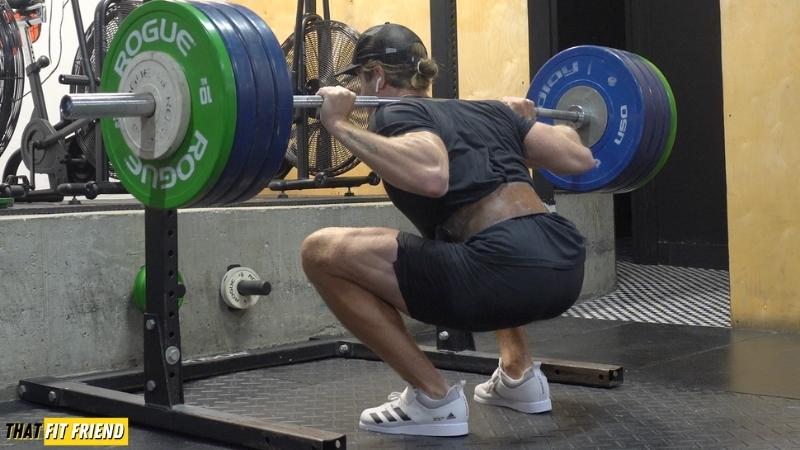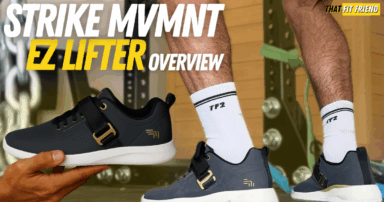If you’re on the quest to improve your squat, you’ve likely considered countless areas of performance that can help increase your squat strength. In fact, you’ve likely considered lifting shoes to help improve your squat strength.
Lifting shoes, more formally known as weightlifting shoes, can be great tools for helping you squat, especially in the context of improving your squat form when squat depth or maintaining an upright torso are issues.
If you’ve been on the fence about using weightlifting shoes for your squat, I’ll help discuss and break down why and when you’d want to use them to help your squat out.
For context, I’ve been a strength coach for 10+ years now and this is a question that I’ve helped countless clients and YouTube subscribers navigate.
Will Lifting Shoes Help My Squat?
If you’re wanting to improve your squat, then using weightlifting shoes can be a very viable tool for helping you do so. Their elevated heel can help promote better squat mechanics when it comes to achieving greater depth and a more upright torso position.
At face value, this all sounds great in theory, but I think it’s important to understand the “why” here regarding using weightlifting shoes to help your squat and the “when” behind when to invest in a pair and use them.
Note, if you’re a beginner just starting on your iron and squat journey, I have written an article about using weightlifting shoes for beginners, and I’d highly suggest checking out that content.
Why Can Lifting Shoes Help My Squat?
A weightlifting shoe is a specific type of footwear that was originally built for the sport of weightlifting. If you’re new to strength sports, weightlifting is the sport that contests the snatch and clean & jerk, AKA the lifting sport that you see in the summer Olympics.
Now, weightlifting shoes can be used for a lot more than the sport of weightlifting. You can use weightlifting shoes for squats, machine work like leg presses and hack squats, and even for performing things like quad-biased lunges and split squats.
Weightlifting shoes are built with a purposely elevated heel that can range between .5-1 inch (12mm-25mm) in height. This brings up a weightlifting shoe’s heel-to-toe drop a significant amount compared to traditional training shoes.
- Heel-to-toe Drop: The height difference between where your foot’s forefoot sits in relation to your heel when wearing a shoe.
For context, your standard training shoe’s heel-to-toe drops sit between 2-9mm, which is a significant difference compared to the 12mm-25mm that you’ll get from weightlifting shoes.
This is important to understand because a higher heel-to-toe drop will influence squat mechanics because it will change your foot position when squatting which will then alter your ankle, knee, and hip angles.
More specifically, your foot will start in a plantarflexed position in a weightlifting shoe whereas it sits flatter in traditional training. Plantarflexion is the action at the ankle when we flex the forefoot down.
By starting with the foot in a plantarflexed position we then create an environment at the ankle in which we can track the knees more over the toes while remaining balanced.
Weightlifting shoes DO NOT increase ankle range of motion by themselves, however, they can allow us to track the knees further over the toes in the squat which could have some carryover to feeling more stable and confident when accessing deeper ranges.
The increased ability to track the knees over the toes can then translate to us achieving greater squat depth while maintaining a more upright torso position. Because we have something to “sit back” on, we can feel more balanced squatting with weightlifting shoes.
With a more upright torso position, we can then maintain a better midfoot position with the barbell. While “midfoot” has a range, when squatting, you ideally want to keep the barbell relatively over your center of mass throughout the entire range of motion.
In layman’s terms, this is my strength coaching way of saying that weightlifting shoes can help with squats because they can allow us to achieve more depth while feeling balanced which can then shift our torso position more upright to keep the barbell moreover the midfoot.
Below, I’ll outline a couple of scenarios where weightlifting shoes can lifters make significant improvements on their squat.
Author’s Note: You DO NOT necessarily need a pair of weightlifting shoes to benefit from squatting with an elevated heel. If your gym has a good wedge, then this will work all of the same for improving your squat.
1. You Keep Falling Forward When Squatting
If you’re squatting and you notice that you keep falling or losing your balance forward, then you likely have an issue with the barbell shifting too far forward from your center of mass. I call these folding chair squats.
In practice, this looks like a torso that keeps folding over when squatting. This will generally happen during the eccentric or the lowering portion of the squat as you hit your end range of motion and start to transition into standing up with the weight.
If this sounds like you, then you may want to experiment with weightlifting shoes or elevating the heel because this can help with your torso position and prevent some of that falling forward that you’re currently experiencing with your footwear.
A good example of this is the lifter that is using flat shoes for squats but doesn’t possess the mobility to sink into deeper ranges without falling forward with the squat style that they’re using.
2. You Keep Coming Up On Your Toes When Squatting
If you’re squatting with the barbell and you notice that you can keep a flat foot position this could be due to ankle mobility or the lack of feeling balance while squatting.
In this context, a weightlifting shoe can help because its elevated heel will replicate what your foot is doing naturally when coming up on your toes, but you’ll have more surface area to stay balanced and produce force into the ground.
A weightlifting shoe can be a useful tool when you’re coming on your toes because it can help you feel more comfortable squatting at different ranges of motion which can have carryover to your squat when not using weightlifting shoes.
Basically, weightlifting shoes can be a nice tool to train your brain to feel more comfortable and stable while squatting if you have issues with coming up on the toes.
3. You Keep Experiencing A Lot of Butt Wink
If you’re experiencing a lot of butt wink when squatting, then you may want to experiment with using weightlifting shoes or a wedge. Buttwink is the term for a pelvis that is tucking excessively when squatting.
Typically, you’ll see butt wink happen at the end range of motion during the eccentric when squatting. Butt wink is not necessarily a “dangerous” thing when squatting like most on social media make it out to be, but it can hinder performance in some contexts.
For example, if you’re trying to squat to depth and progress the weight you’re using but you notice butt wink is causing you to fatigue at a faster rate, then you may want to tweak your form to work away from this.
By elevating the heel, you’ll typically see lifters be able to maintain a more rigid or structured hip and torso position with much less butt wink. In this context, weightlifting shoes can be a useful tool.
Can I Use Wedges Instead of Weightlifting Shoes?
If you don’t feel like investing in a pair of weightlifting shoes and you or your gym has a good wedge or wedges, then you can absolutely use them for helping your squat.
A wedge will essentially do the same thing that weightlifting shoes will do. Plus, wedges can be great because you can keep on the shoes you’re currently training in whether that’s cross-training shoes or barefoot shoes.
Note, while I love wedges for squats, there are a few caveats that come along with them that you should keep in mind. First, wedges can be tough to transport if your gym doesn’t have them. Good metal wedges can weigh more than you’re likely willing to cart around.
Second, wedge heights can vary pretty drastically. For example, there’s a huge difference between squatting on a 10-15 degree wedge versus a 25-30 degree wedge. Higher-angle wedges are usually not the most beneficial for squat form carryover purposes.
Third, wedges have limited use contexts. Weightlifting shoes are great because they’re a lot more mobile and have more capabilities. You can use them for squats, leg presses, hack squats, snatches, and clean & jerks, whereas wedges will only be useful in static living contexts.
All that being said, wedges are awesome and can replicate what weightlifting shoes will do when helping your squat, but they can come with some limitations.
Frequently Asked Questions (FAQ)
Q:Will lifting shoes help my squat?
Q:Do I need lifting shoes?
Takeaway Thoughts
Lifting shoes, AKA weightlifting shoes or squat shoes, can be awesome tools for helping you improve your squats. Their elevated heel can promote stronger squat mechanics when you’re falling forward, coming up on your toes, or experiencing buttwink.
By no means do you need lifting shoes to improve your squat, but they can be a nice tool to keep in your training toolbox. Plus, I think it can be useful having some contrast between squatting with a flatter shoe versus a shoe with an elevated heel.
On top of this, if you plan to ever compete in strength sports like weightlifting, powerlifting, CrossFit, or even strongman, it’s a good idea to familiarize yourself with lifting shoes and how they can influence your squat performance.
If you have additional questions on this topic, drop a comment below or reach out to me personally via Instagram (@jake_boly or @that_fit_friend).
















Add a Comment